Ahlhorner cellar stones
| Ahlhorner cellar stones Erdmannsteine | ||
|---|---|---|
|
|
||
| Coordinates | 52 ° 52 '52 " N , 8 ° 16' 51.5" E | |
| place | Grossenkneten , Lower Saxony , Germany | |
| Emergence | 3500 to 2800 BC Chr. | |
| Sprockhoff no. | 939-940 | |
The Ahlhorner Kellersteine (also called Erdmannsteine I and II) are two Neolithic large stone graves of the passage grave or large dolmen type with the Sprockhoff numbers that are about 50 m apart . 939 and 940. They originated between 3500 and 2800 BC. And are megalithic systems of the funnel beaker culture (TBK).
The passage grave is a form of Neolithic megalithic systems , which consists of a chamber and a structurally separated, lateral passage. This form is primarily found in Denmark, Germany and Scandinavia, as well as occasionally in France and the Netherlands. Based on the ceramic finds, both plants are assigned to the older to middle phase of the western group of the TBK. “Neolithic monuments are an expression of the culture and ideology of Neolithic societies. Their origin and function are considered to be the hallmarks of social development ”.
location
The stones are located about 350 m south of the A1 and 250 m north of the sand-shaped Aue lowland stream , about 1100 m from the large stone grave Heidenopfertisch near Endel (Visbek) , in a forest area of the Großenkneter district of Ahlhorn , district of Oldenburg , in the nature reserve Bäken der Endeler and Holzhauser Heide . The name "Kellersteine" is represented three times in the Wildeshauser Geest . The other two groups are the stone lodges to the east and the Holzhauser cellar stones .
Ahlhorner Kellersteine I (also Erdmannsteine I)
The northwest-southeast-oriented western facility (No. 939) is a trapezoidal passage grave ( Emsland Chamber type ) eleven meters long and 3.0 by 2.3 meters wide. Of the once 17 bearing stones, 15 have been preserved (seven on the north-eastern, six on the south-western long side and both keystones), as well as all five cap stones, two of which, however, are fragmented. The largest capstone is 4.5 × 2.1 × 1 meters in size. Both bearing stones are missing on the south side of the middle (blown) capstone. The access to the chamber is said to have been located here. Nothing has survived from the original edging stones or the hill.
- Ahlhorner-Kellersteine-West
Ahlhorner Kellersteine II (also Erdmannsteine II)
The east-west oriented trapezoidal east of the two plants (No. 940) lies in a remnant of a round hill 14 m in diameter. The chamber is six meters long. Their width decreases from 2.5 to 2.0 m. The two long sides of the chamber have four bearing stones. Since only one keystone has been preserved and there is no access from the side, it may be one of the large dolmen that is rare in this region. Of the formerly at least three capstones, one is still present in situ , the other has broken and collapsed with the fracture surface inwards into the complex.
- Ahlhorner-Kellersteine-East
See also
- Nordic megalithic architecture
- The facilities are part of the Route of the Megalithic Culture .
literature
- Anette Bußmann : Stone Age witnesses. Travel to the prehistory of northwest Germany. Isensee Verlag, Oldenburg 2009, ISBN 978-3-89995-619-1 , p. 89.
- Mamoun Fansa : large stone graves between Weser and Ems. Isensee Verlag, Oldenburg 1992, ISBN 3-89442-118-5 , pp. 110-113.
- Ernst Sprockhoff : Atlas of the megalithic tombs Germany. Part 3: Lower Saxony - Westphalia. Rudolf Habelt Verlag, Bonn 1975, ISBN 3-7749-1326-9 , p. 133.
Web links
- Description, plan and pictures (last accessed on December 17, 2012)
- Navigator: more interactive focused on the Ahlhorn cellar stones. Official map service of the LGLN
Individual evidence
- ↑ J. Müller In: Varia neolithica VI 2009 p. 15








